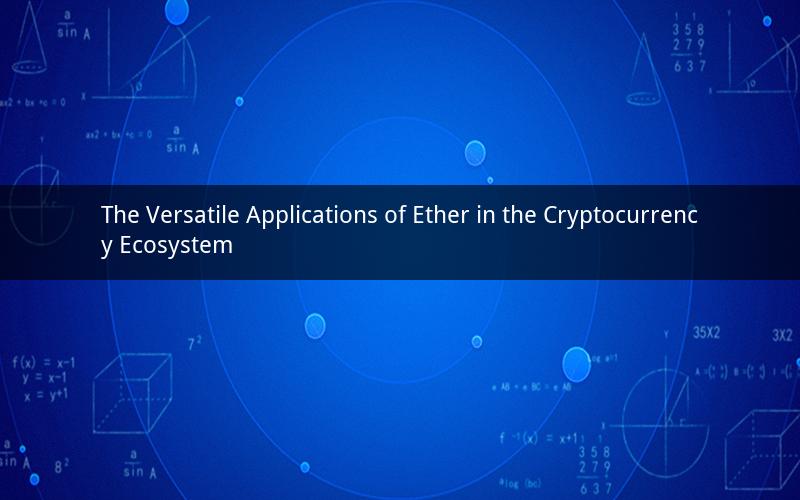
In the rapidly evolving world of cryptocurrencies, Ether stands as one of the most significant digital assets. Beyond its role as the native currency of the Ethereum network, Ether has a multitude of uses that contribute to the broader cryptocurrency ecosystem. This article delves into the various applications of Ether, highlighting its importance in the crypto space.
1. Facilitating Smart Contracts
One of the primary uses of Ether is to facilitate the execution of smart contracts. Smart contracts are self-executing contracts with the terms of the agreement directly written into lines of code. They run on the Ethereum network and eliminate the need for intermediaries. Ether is used to pay for the computational resources required to run these contracts, making it an essential component of the Ethereum platform.
2. Rewarding Miners
In the Ethereum network, miners play a crucial role in securing the network and validating transactions. They use their computing power to solve complex mathematical puzzles, and in return, they are rewarded with Ether. This incentivizes miners to participate in the network and ensures its security. The more miners involved, the more secure the network becomes.
3. Building and Deploying DApps
Decentralized applications (DApps) are applications that run on a decentralized network, typically the Ethereum blockchain. These applications are built using smart contracts and can range from decentralized finance (DeFi) platforms to decentralized exchanges. Developers use Ether to deploy and maintain these DApps, as well as to pay for the gas fees required for their execution.
4. Staking and Yield Farming
Ethereum 2.0 introduced the concept of staking, allowing users to earn rewards by locking up their Ether. Users who stake their Ether in the Ethereum network help secure the network and, in return, receive staking rewards. Additionally, yield farming is a popular practice where users lend their Ether to various decentralized lending platforms in exchange for interest payments.
5. Cross-Chain Interoperability
Cross-chain interoperability is the ability of different blockchains to communicate and interact with each other. Ether plays a vital role in this process, as it serves as a bridge between different blockchains. Users can convert their Ether to other cryptocurrencies or tokens, enabling seamless transactions and interactions across various networks.
6. Decentralized Governance
Ethereum's decentralized governance model allows stakeholders to participate in decision-making processes. Users can vote on various proposals, including changes to the network's parameters and the addition of new features. Ether is used to pay for the gas fees associated with these governance activities.
7. Token Creation and Transfer
Ethereum provides a platform for creating and transferring tokens. Developers can use the Ethereum network to issue their own tokens, which can represent ownership, access, or utility. These tokens can be used for various purposes, such as representing shares in a company or acting as a currency within a specific ecosystem.
8. Decentralized Finance (DeFi)
DeFi is a rapidly growing sector within the cryptocurrency ecosystem that enables financial services to be provided without the need for traditional financial intermediaries. Ether is a key component of DeFi, as it is used to pay for transactions, lend and borrow funds, and participate in various DeFi protocols.
9. Decentralized Autonomous Organizations (DAOs)
DAOs are organizations governed by smart contracts and run by their members. Ether is used to participate in DAOs, as members can vote on proposals and contribute to the organization's activities. DAOs are designed to be transparent, democratic, and free from centralized control.
10. NFTs and Digital Art
Non-fungible tokens (NFTs) are unique digital assets that represent ownership of a specific item, such as a piece of art or a collectible. Ether is used to purchase NFTs, as well as to pay for the gas fees associated with minting and transferring these tokens.
In conclusion, Ether's applications in the cryptocurrency ecosystem are diverse and multifaceted. From facilitating smart contracts to enabling cross-chain interoperability, Ether plays a crucial role in the growth and development of the crypto space. As the Ethereum network continues to evolve, it is likely that Ether will find new and innovative uses within the cryptocurrency ecosystem.
Questions and Answers:
1. Q: What is the primary purpose of Ether in the Ethereum network?
A: The primary purpose of Ether in the Ethereum network is to facilitate the execution of smart contracts and pay for the computational resources required to run these contracts.
2. Q: How does staking work on the Ethereum network?
A: Staking on the Ethereum network involves locking up Ether to participate in the consensus process and secure the network. In return, stakers receive staking rewards based on their contribution to the network's security.
3. Q: What are DApps, and how do they use Ether?
A: DApps are decentralized applications built on the Ethereum network. They use Ether to pay for gas fees associated with their execution and maintenance, as well as to deploy and upgrade their smart contracts.
4. Q: How does cross-chain interoperability work, and what role does Ether play in it?
A: Cross-chain interoperability allows different blockchains to communicate and interact with each other. Ether serves as a bridge between these blockchains, enabling users to convert their Ether to other cryptocurrencies or tokens for seamless transactions.
5. Q: What are NFTs, and how do they use Ether?
A: NFTs are unique digital assets that represent ownership of a specific item, such as art or collectibles. Ether is used to purchase NFTs and pay for the gas fees associated with minting and transferring these tokens.